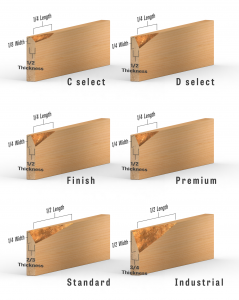This chart depicts the largest size Black Knots permissible in each grade according to nominal board width. To properly measure a knot, take a measurement of the width and a measurement of the length, add the two measurements together and divide the total by two to get the average diameter of the knot.
(Length + Width)/2 = Average Knot Diameter
To see a demonstration of a spike knot measurement, click on the instructional video segment below.
| Black Knot Size by Nominal Width | ||||||
| Grade | Knot Quality | 4” | 6” | 8” | 10” | 12”+ |
| C Select | Sound and Tight | One pin knot (1/2″ or smaller) per 4 surface feet | ||||
| D Select | Sound and Tight | One pin knot (1/2″ or smaller) per 1 surface foot* | ||||
| Finish | Sound and Tight | 5/8” | 3/4” | 3/4″ | 7/8” | 7/8” |
| Premium | Generally Sound and Tight** | 3/4” | 1” | 1-1/4” | 1-1/2” | 1-1/2” |
| Standard | Any Quality | 1-3/4” | 2-3/4” | 3-5/8” | 4” | 4” |
| Industrial | Any Quality | Not Limited by Grade | ||||
* In an occasional piece, one small (maximum 3/4″), sound, tight knot permitted. This knot will be counted as two pin-knots when determining the number of knots permitted in the piece.
** Further information regarding Knot Quality will be discussed in Level 300.

